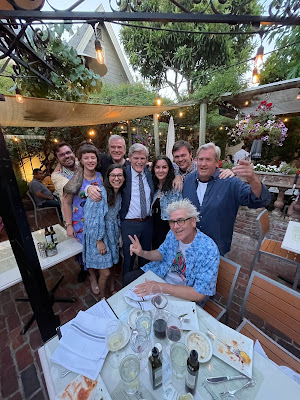What do you MEME?
We returned from the
after party of the wedding at Beltane Ranch in Glen Ellen, California in Sonoma
Valley. Kevin is the youngest of three in Rob’s family married the stunning
Madelyn. The party extended into a small bar in Town Square. Rob and his wife
returned to their home in Novato. Dan was smart enough to retire at a
reasonable hour because he wanted to be awake at Saint Leo Catholic Church in
the morning. (Our brother Sundance and sister Lynn decided not to travel from
their respective homes in New Orleans and Columbus, Ohio to this destination.)
The rental home arranged
for by Rob was roomy with space for all of us. My brother and I along with his
two boys (Wes and Matt), and their respective girlfriends (Alexis and Bianca)
and his step-daughter (Lauren) joined Greg and I as we moved into a comfy
living room space to reflect on the afternoon/evening. Greg decided to take charge by introducing me
as a guest speaker. (We are all improvisational actors in our family so I began
my address to the audience assembled. I borrowed from a recent presentation I
made.)
Uncle Wes (that’s me): Bruce
Lee is an inspiration. He was determined to make it as a box office star in
Hollywood but his ambition was thwarted by producers and directors who were
afraid, that in spite of his success as Kato in the Green Hornet TV series he would
not have enough commercial appeal on the big screen… Bruce Lee was determined
to overcome this Hollywood bias against a Chinese actor with astounding
marshall arts skills.
This is the set up to my
sharing a quote about mindfulness and living life in the moment. “Be Water”
said Bruce Lee…
Alexa (Wes’ girlfriend
has been traveling in close quarters in an RV. She may have been
over-served, very tired or both. So her interaction with the group made her
appear a bit tipsy): What about John Claude Van Damme? She blurted out
the suggestion to change the arc of my little talk. (I get it, but I know next to
nothing about the Belgian Van Damme beyond the fact that he is a movie star.) My talk
is NOT about movies anyway. It is about mindfulness and begins with a Bruce Lee quote
about water.
Uncle Wes: So Bruce
Lee offers some advice in his Marshall Arts and movie acting instruction. Be
Water. Empty your mind. Be formless. Be shapeless. When you put water in a cup,
it becomes the cup…
Alexa (in her best
imitation of a heckler in a small comedy club): This is boring. What about
John Claud Van Damme? She slurs a few arguments as if our small group could
be brought to a vote and change the programming/channel. Who wants to talk
about John Claud Van Damme? Raise your hand!
Wes (He is curled up into
a ball in an overstuffed chair and close to being asleep.) He stretches a bit
and calmly puts it out there that Alexis has completely de-railed Uncle Wes. He
tries to mitigate the problem with a group game called WHAT DO YOU MEME? Since Wes and Alexis have
played this game before, he assumes that this activity might be easier to
control.
Uncle Wes: Great, we can
move on to this game. An image is offered on an easel in the middle. Players
chose a caption from their hand (five cards). Captions deemed best win the image. The point is
awarded to the agreed upon winning caption. At the end the winner is the player
with the most image cards wins. Simple enough.
Matt and Bianca (on the
couch) were politely attentive to Uncle Wes but flexible enough to let the
evening festivities move on to this game.
Lauren bailed out and
went to bed. She likely prefers more orderly proceeding and can see that step
Dad Greg and Uncle Wes only have the sketchiest idea how this gathering will be
engaged. That still leaves the six of us to salvage the order of events.
Wes (stretching): Alexis, shut the f@*k up.
Alexa: This is all
about racism. No, this is because of Misogyny. You are being a misogynist! (It
isn’t clear if she is referring to the game or the attempt to bring some order
to the emerging chaos.)
Uncle Wes: Well said
Alexa. (Or sometimes he addresses her as Siri as he easily forgets the name Alexis in the context of the game). We girls need to stick together. Now Greg, we are gonna need you to take
a time out. You are being disruptive to the game.
Wes: It’s my turn and
my image card is of Russian leader Vladimir Putin. I think this will one day be
promoted as the Putin collector edition of this game of WHAT DO YOU MEME?
Alexis: Wait a minute!
You are all misogynists and you are skipping me.
Bianca: No. It’s Wes’
turn. It is alright. (Matt is laughing and both Matt and Bianca know that
law and order will not be restored in the living room. Only a kind of orderly
chaos is possible now.)
The dynamics and stage
direction cannot do justice to the comic timing and natural twists and turns of
this gathering that rolled on with many laughs. Uncle Wes did his best to
explain the performance as a blend of one act dramatic performance art, method
acting and improvisational theater. Uncle Wes insisted This performance art is
much like Voltaire’s theme proclaimed again and again in Candide. Everything
happens exactly as it is supposed to happen in this, the best of all possible
worlds.





.JPG)



